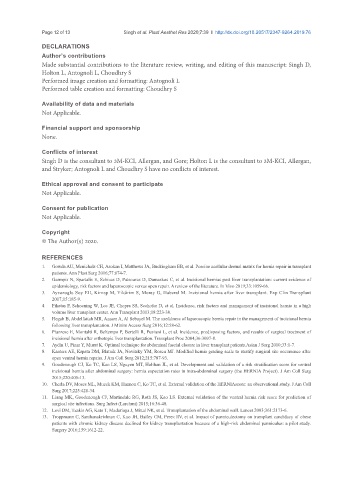Page 430 - Read Online
P. 430
Page 12 of 13 Singh et al. Plast Aesthet Res 2020;7:39 I http://dx.doi.org/10.20517/2347-9264.2019.76
DECLARATIONS
Author’s contributions
Made substantial contributions to the literature review, writing, and editing of this manuscript: Singh D,
Holton L, Antognoli L, Choudhry S
Performed image creation and formatting: Antognoli L
Performed table creation and formatting: Choudhry S
Availability of data and materials
Not Applicable.
Financial support and sponsorship
None.
Conflicts of interest
Singh D is the consultant to 3M-KCI, Allergan, and Gore; Holton L is the consultant to 3M-KCI, Allergan,
and Stryker; Antognoli L and Choudhry S have no conflicts of interest.
Ethical approval and consent to participate
Not Applicable.
Consent for publication
Not Applicable.
Copyright
© The Author(s) 2020.
REFERENCES
1. Gowda AU, Mcnichols CH, Asokan I, Matthews JA, Buckingham EB, et al. Porcine acellular dermal matrix for hernia repair in transplant
patients. Ann Plast Surg 2016;77:674-7.
2. Garmpis N, Spartalis E, Schizas D, Patsouras D, Damaskos C, et al. Incisional hernias post liver transplantation: current evidence of
epidemiology, risk factors and laparoscopic versus open repair. A review of the literature. In Vivo 2019;33:1059-66.
3. Ayvazoglu Soy EH, Kirnap M, Yildirim S, Moray G, Haberal M. Incisional hernia after liver transplant. Exp Clin Transplant
2017;15:185-9.
4. Fikatas P, Schoening W, Lee JE, Chopra SS, Seehofer D, et al. Incidence, risk factors and management of incisional hernia in a high
volume liver transplant center. Ann Transplant 2013;18:223-30.
5. Hegab B, Abdelfattah MR, Azzam A, Al Sebayel M. The usefulness of laparoscopic hernia repair in the management of incisional hernia
following liver transplantation. J Minim Access Surg 2016;12:58-62.
6. Piazzese E, Montalti R, Beltempo P, Bertelli R, Puviani L, et al. Incidence, predisposing factors, and results of surgical treatment of
incisional hernia after orthotopic liver transplantation. Transplant Proc 2004;36:3097-8.
7. Aydin U, Pinar Y, Murat K. Optimal technique for abdominal fascial closure in liver transplant patients.Asian J Surg 2010;33:1-7.
8. Kanters AE, Krpata DM, Blatnik JA, Novitsky YM, Rosen MJ. Modified hernia grading scale to stratify surgical site occurrence after
open ventral hernia repairs. J Am Coll Surg 2012;215:787-93.
9. Goodenough CJ, Ko TC, Kao LS, Nguyen MT, Holihan JL, et al. Development and validation of a risk stratification score for ventral
incisional hernia after abdominal surgery: hernia expectation rates in intra-abdominal surgery (the HERNIA Project). J Am Coll Surg
2015;220:405-13.
10. Cherla DV, Moses ML, Mueck KM, Hannon C, Ko TC, et al. External validation of the HERNIAscore: an observational study. J Am Coll
Surg 2017;225:428-34.
11. Liang MK, Goodenough CJ, Martindale RG, Roth JS, Kao LS. External validation of the ventral hernia risk score for prediction of
surgical site infections. Surg Infect (Larchmt) 2015;16:36-40.
12. Levi DM, Tzakis AG, Kato T, Madariaga J, Mittal NK, et al. Transplantation of the abdominal wall. Lancet 2003;361:2173-6.
13. Troppmann C, Santhanakrishnan C, Kuo JH, Bailey CM, Perez RV, et al. Impact of panniculectomy on transplant candidacy of obese
patients with chronic kidney disease declined for kidney transplantation because of a high-risk abdominal panniculus: a pilot study.
Surgery 2016;159:1612-22.

